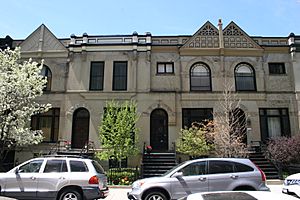Henry Gerber House facts for kids
|
Henry Gerber House
|
|
|
U.S. Historic district
Contributing property |
|

East (front) elevation, 2013
|
|
| Location | Chicago |
|---|---|
| Built | 1885 |
| Architectural style | Queen Anne |
| Part of | Old Town Triangle Historic District (ID8400034) |
| NRHP reference No. | 15000584 |
Quick facts for kids Significant dates |
|
| Added to NRHP | July 21, 2015 |
| Designated NHL | July 21, 2015 |
| Designated CP | November 8, 1984 |
The Henry Gerber House is a special building in the Old Town neighborhood of Chicago, Illinois. It's a brick row house built in 1885. This house is important because it was once home to Henry Gerber. He was a German-born man who started the first American organization for equal rights. This group worked to help people who were treated unfairly because of who they were.
Gerber held meetings and published newsletters from this house. These were the first known publications in the country that talked about equal rights for people who were different. In 1925, police came to the house, and the group stopped its work.
The Gerber House is part of the Old Town Triangle Historic District. It was named a Chicago Landmark in 2001. In June 2015, it became a National Historic Landmark. This means it's one of the most important historic places in the United States.
Contents
A Special House in Chicago
The Henry Gerber House is located on North Crilly Court. This is a quiet street in the Old Town area of Chicago. The neighborhood is full of similar two-story houses. Most of these homes were built in the late 1800s. The streets are lined with trees, making it a pleasant place. The area is flat, which is common for places near Lake Michigan.
What Does the House Look Like?
The house is made of brick and has two stories. It has a flat roof. The front of the house faces east. It has two sections that stick out a bit. A small garden with a wrought iron fence sits in front of the house.
Outside Details
You can see a window in the basement level that looks out onto the garden. Stone stairs lead up to the main front door. Above the door is a round window with a stone arch around it. There's also a large window next to the door.
Between the first and second floors, there's a decorative line. The second floor has an arched window and another smaller window. The roofline has different designs. On one side, there's a fancy border. On the other side, above the arched window, there's a pointed section called a gable.
Inside Details
When you enter the house, you step into a small entry area with original floor tiles. This leads into the living room, which has a fireplace. An arched opening connects the living room to the dining room. The kitchen is at the back of the house. It has modern glass doors that open to a wooden deck.
Stairs lead down to the basement and up to the second floor. In the basement, the original brick walls are now covered. The upper floor has two original bedrooms. One of these is now used as an office. The main bedroom has a small bathroom and another fireplace.
Who Was Henry Gerber?
Henry Gerber was born in Germany in 1892. He moved to the United States as a young man. He lived in Chicago in the 1920s. During his time in Germany, he saw groups working for equal rights for people who were treated unfairly. This inspired him to do something similar in America.
Working for Fairness
In 1924, Henry Gerber started an organization called the Society for Human Rights. This group was the first of its kind in the United States. Its goal was to work for fair treatment and equal rights for people who were different. Gerber held meetings in his apartment at this house. He also published newsletters called "Friendship and Freedom." These were the first magazines in the country to talk about these important rights.
However, the group's work was short-lived. In 1925, the Chicago police raided the house. This event caused the Society for Human Rights to close down. Even though it lasted only a year, it was a very important first step in the fight for equal rights in America.
A Historic Landmark
The Henry Gerber House has been recognized for its historical importance many times.
- In 1977, it became a contributing property to the Old Town Triangle Chicago Landmark District.
- In 1984, it was listed on the National Register of Historic Places. This is a list of places important to American history.
- In 2001, the city of Chicago named it a Chicago Landmark.
- In 2015, it was named a National Historic Landmark. This is the highest level of historical recognition in the United States. It shows how important Henry Gerber's work was.

